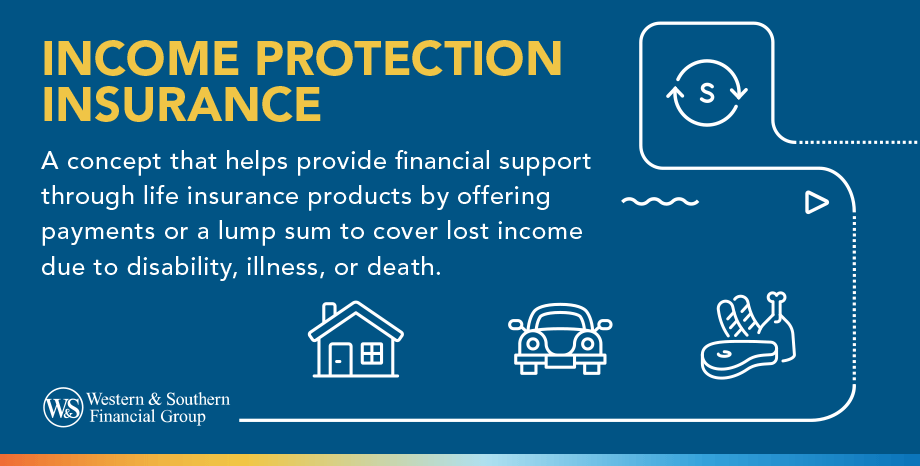Video Transcript
Today we're exploring a financial strategy that can be used with different life insurance products to help secure your family's financial future - income replacement. Life insurance can be more than just leaving behind a lump sum. It's about helping your family maintain their lifestyle, even if you're not around.
Income replacement is a concept in life insurance designed to provide ongoing financial support by replacing your salary in the event of your death. Various life insurance products, such as term or whole life insurance, can be used to help provide income replacement for beneficiaries in the event of the insured's death. Some life insurance policies offer payout options that allow beneficiaries to receive the death benefit in installments, such as monthly payments, instead of a lump sum. This can help provide financial support following the insured's passing. Here's how it works.
When you buy a life insurance policy you choose a coverage amount that reflects your annual income and how long your family would need support. You pay your premiums to keep the coverage active. In the event of your death, some policies instead of a lump sum can be structured so that your family receives monthly payments. These payments continue for a period defined in the policy.
The benefits of using life insurance for income replacement include financial stability by providing ongoing financial support to help your family maintain their standard of living. Second, budget management. This may help make it easier for those that would prefer to manage money on a monthly basis rather than a large sum. And lastly adaptability. Policies may be able to be adjusted as your financial circumstances change, such as increases in salary or changes in dependents.
While life insurance for income replacement has many advantages, there are several considerations to keep in mind. First, coverage duration. It's crucial to determine how long your family would need the support. Consider factors like the ages of your children and your spouse's retirement plans. Also consider inflation. The value of the fixed monthly income might decrease over time, so some policies include inflation protection clauses. And lastly, inflation protection riders typically come with an additional cost, so you should weigh the benefits.
Choosing the right life insurance policy with income replacement benefits involves several steps. First, assess your needs. Calculate your current income, your family's expenses, and future financial goals. Second, get professional advice. Speak with an insurance professional who can provide guidance based on your specific circumstances. And lastly, compare offers. Look at different policies from various insurers to find the best rates and terms that fit your needs.
Thanks for joining us today on how life insurance can help provide income replacement for beneficiaries. It's a powerful tool that can help secure your family's financial future.
Why You Need Income Protection Insurance
Income protection insurance, or disability insurance, is a crucial financial tool that helps protect your livelihood if you cannot work due to illness or injury. Understanding its importance can help ensure your and your family's financial security during challenging times.
Income protection insurance provides a portion of your income if you cannot work due to a disability. It acts as financial protection, helping you cover essential expenses like mortgage payments, utility bills, and daily living costs when you can't earn your regular paycheck.
Anyone who relies on their income to support themselves or their family should consider income protection insurance. This includes:
- Sole Breadwinners: If you're your household's primary or sole earner, losing your income could significantly impact your family's financial stability.
- Dual-Income Families: Even if both partners work, losing one income can disrupt your financial plans and savings goals.
- Self-Employed Individuals: Without employer-provided benefits, self-employed workers must secure their income independently.
- Employees Without Adequate Coverage: Some employers offer disability insurance, but it may not be enough to cover all your expenses.
Income protection insurance is not just for those in high-risk jobs; it's a vital part of financial strategy for anyone who depends on their earnings. By securing a reliable income source in the event of a disability, you protect your financial future and ensure you can confidently navigate life's uncertainties.


How Income Protection Insurance Works
Income protection insurance typically pays out a percentage of your pre-disability income if you cannot work due to illness or injury. The amount you receive depends on the policy's terms and conditions, which may vary based on occupation, age, health status, and income level. Here are some basic steps to understand how income protection insurance works:
- Policy Purchase: Like other types of insurance, you begin by purchasing a policy. Your premium depends on factors like age, occupation, health, and the coverage you need.
- Coverage Details: Policies typically cover 50% to 70% of your gross income. This amount is designed to help you manage essential expenses while you recover.
- Waiting Period: After you become disabled, there's usually a waiting period, known as the elimination period, before benefits kick in. Depending on your policy, this period can range from a few weeks to several months.
- Benefit Period: You'll receive benefits once the waiting period ends. These payments continue until you can return to work or until the end of the benefit period, which could be a few years or until retirement, depending on your policy.
- Claim Process: To receive benefits, you must file a claim with your insurance provider, providing proof of your disability. This often includes medical records and a statement from your doctor.
Income protection insurance offers assistance in case you can't work due to a disability. By understanding how it works and selecting the right policy, you can ensure that your financial stability remains intact, allowing you to focus on recovery and maintaining your lifestyle.
Types of Income Protection Insurance
Depending on their needs and preferences, several types of income protection insurance are available to individuals. Some standard options include:
Short-Term Disability Insurance
This type of insurance covers a limited period, typically up to six months. It is designed to replace a portion of your income if you cannot work due to a temporary disability, such as an illness or injury.
Long-Term Disability Insurance
Long-term disability insurance provides coverage for an extended period, sometimes up to retirement age. It is designed to replace a portion of your income if you cannot work due to a long-term disability.
Group Disability Insurance
This type of insurance is typically offered through employers as part of their benefits package. It provides coverage for all eligible employees and may offer more affordable rates than individual policies.
Individual Disability Insurance
Individual disability income insurance offers more flexibility regarding coverage options and benefit amounts. Individuals can purchase disability insurance directly to provide coverage for a specific amount based on their needs.
Social Security Disability Insurance (SSDI)
SSDI is a federal program that provides income protection benefits to individuals unable to work due to a disability. To qualify, you must have a qualifying disability and meet specific criteria set by the Social Security Administration.
Before choosing an income protection insurance policy, assess your needs, research options, and consult a financial professional. Understand the types of coverage, waiting periods, benefit periods, and claim processes to ensure the policy suits your situation.
Consider different income protection insurance options. Get a Life Insurance Quote
Benefits of Income Protection Insurance
Income protection insurance is beneficial for many families, ensuring you have financial support if you cannot work due to illness or injury. This coverage helps maintain your current living standard and ensures you can meet your financial obligations even when you are not earning a regular paycheck. Here are some of its benefits:
- Financial Stability During Tough Times: When the primary breadwinner can't work due to illness or injury, income protection insurance provides a steady income. This helps maintain the family's financial stability, covering essential expenses like mortgage payments, groceries, and utility bills.
- Help Protect Your Lifestyle: This insurance ensures that your standard of living stays the same if you can't work. You can keep up with daily expenses and maintain your lifestyle without dipping into savings or retirement funds.
- Covers Medical Expenses: Some policies can also cover medical bills arising from an injury or illness that causes an inability to work. This can reduce the financial burden on your family and help you focus on recovery.
- Security: Knowing you have assistance can alleviate stress. This security lets you focus on your health and well-being rather than worrying about making ends meet.
- Supplement to Other Benefits: Income protection insurance can supplement benefits like Social Security or worker's compensation. These programs often don't provide enough to cover all expenses, and this insurance can fill in the gaps.
- Long-term Security: Many policies offer benefits lasting several years or until retirement age. This long-term support can be crucial for dealing with a chronic condition or a lengthy recovery period.
- Customizable Plans: Income protection insurance policies can often be tailored to your needs. You can choose the amount of coverage, the waiting period before benefits begin, and the time the benefits will be paid.
- Tax Benefits: Your income protection insurance premiums can sometimes be tax-deductible. Additionally, depending on your policy and local laws, the benefits you receive may be tax-free.
- Helps with Debt Management: If you have loans or credit card debt, income protection insurance can help you keep up with payments. This prevents you from falling behind and facing high interest rates or penalties.
- Eases Return to Work: When you're financially secure, you can take the necessary time to recover fully before returning to work. This can lead to a more prosperous and less stressful reintegration into your job or even a new career path if needed.
Income protection insurance is a practical way to safeguard your family's future and ensure you can handle life's unexpected challenges. By understanding these benefits, you can decide whether this type of insurance is right for you.
Potential Drawbacks of Income Protection Insurance
Income protection insurance provides assistance if you can't work due to injury or illness. However, like any financial product, it has its downsides. Here are some potential drawbacks to consider:
- High Premium Costs: Income protection insurance can be expensive. Premiums vary based on age, occupation, and health. For some, the cost might outweigh the potential benefits, especially if they have a tight budget.
- Lengthy Waiting Periods: Policies often come with waiting periods before benefits kick in, ranging from 30 to 180 days or more. You won't receive any payments during this time, which can be a financial strain if you don't have enough savings.
- Limited Coverage Amounts: Most policies only cover a percentage of your income, typically between 50% and 70%. This reduction can significantly impact your ability to maintain your current lifestyle if you become disabled.
- Strict Definitions of Disability: Insurance companies have specific definitions of a disability. You won't receive benefits if your condition doesn't meet their criteria. This can be frustrating if you’re unable to work but not considered "disabled" by the policy standards.
- Exclusions and Limitations: Policies may exclude certain conditions or limit benefits for specific illnesses or injuries. It's crucial to read the fine print to understand what is and isn't covered, as these exclusions can affect your coverage.
- Complex Claim Process: Filing a claim can be complicated and time-consuming. Insurers may require extensive documentation and medical evaluations, leading to delays in receiving benefits.
- Taxable Benefits: Your benefits could be taxable if you pay for the policy with pre-tax dollars. This tax liability can reduce the amount of money you get during a disability period.
- Non-Guaranteed Renewability: Some policies are not guaranteed renewable, meaning the insurer can cancel the policy or increase premiums. This uncertainty can be concerning, especially if your health declines and you need coverage.
- Policy Lapses: If you miss a premium payment, your policy could lapse, leaving you without coverage when needed most. It's essential to keep up with payments to avoid this risk.
- Moral Hazard: Income protection insurance can sometimes lead to moral hazard, where the insured might have less incentive to return to work quickly. Insurers may scrutinize claims to ensure claimants are genuinely unable to work, which can add stress during an already challenging time.
Understanding these potential drawbacks is vital when considering income protection insurance. Weighing the pros and cons helps ensure you make an informed decision that aligns with your financial goals and needs.
How Does Income Protection Help Life Insurance
Income protection is a crucial aspect of life insurance that ensures your family can maintain their standard of living if you pass away. When you have a life insurance policy, the death benefit can replace your income, helping cover daily expenses like rent, groceries, and utilities. This support allows your loved ones to manage financially, reducing the immediate pressure to find new sources of income or drastically cut expenses.
Use our life insurance calculator to determine your coverage needs
Moreover, income protection can help cover long-term financial goals and obligations. This might include paying off a mortgage, funding child care, helping pay off student loans, or saving for future needs. Securing a life insurance policy with sufficient coverage provides a financial cushion that allows your family to stay on track with their plans and commitments, even in your absence.
Income protection through life insurance is a vital safety net for your family's financial stability. It ensures that your loved ones can continue to meet their immediate needs and long-term goals, offering essential support during a challenging time. Understanding and utilizing income protection in life insurance can make a significant difference in preserving your family's financial well-being.
Key Considerations
Income protection insurance helps ensure that you have a source of income if you cannot work due to illness or injury. Here are some tips to consider when thinking about income protection insurance:
- Understand Your Needs: Before buying income protection insurance, consider your monthly expenses and how long you could manage without your regular income. Choose a policy that fills that gap.
- Know the Types of Policies: There are two main types of income protection insurance: short-term and long-term. Assess your situation to determine which type, or combination of both, best suits your needs.
- Check the Elimination Period: The elimination period is the waiting time before benefits start. It ranges from 30 to 90 days for short-term and 90 days to six months for long-term policies. More extended periods reduce premiums but require using savings initially.
- Look at the Benefit Amount: The benefit amount is the percentage of your income the policy will replace. Most policies cover between 50% to 70% of your pre-tax income. Ensure this amount is enough to cover your essential expenses.
- Understand the Definitions of Disability: Policies define disability differently. Some cover you if you can't perform your specific job, while others cover you only if you can't work any job. Own-occupation policies are pricier but provide broader coverage.
- Consider Additional Features: Many income protection policies offer cost-of-living adjustments (COLA) to keep up with inflation and increase options to raise coverage as your income grows without more medical exams. Evaluate these options to enhance your coverage.
- Review the Insurance Provider: Choose a reputable company with strong financial ratings and good customer service. Check reviews and ratings from agencies like AM Best, Moody's, or Standard & Poor's to ensure reliability and economic stability.
- Compare Quotes: Insurance premiums vary widely between providers. Get quotes from multiple companies to compare costs and benefits and understand each policy's coverage and exclusions.
- Seek Financial Professional Advice: Consult a financial planner or insurance advisor for personalized recommendations based on your financial situation and goals.
- Read the Fine Print: Read the policy details carefully, including exclusions and conditions, to understand coverage and avoid surprises when filing a claim.
Income protection insurance is an essential safeguard for your financial stability. By understanding your needs and options, you can choose a policy that provides the right level of protection for you and your family.
Conclusion
Income Protection Insurance is an essential safeguard for anyone who relies on their income to meet financial obligations. It helps provide security and economic stability during challenging times. Don't wait until it's too late—explore your options and secure a policy today to protect your future. Contact an insurance advisor now to get started.
Help secure your financial future by exploring your options. Get a Life Insurance Quote
Frequently Asked Questions
What is the income protection rule?
The income protection rule is a guideline for determining how much life insurance you need. It suggests you should aim for a policy that covers 5 to 10 times your annual salary. This helps ensure your family can maintain their standard of living if you are no longer there to provide for them.
What does loss of income insurance cover?
Loss of income insurance, or disability insurance, covers a portion of your salary if you cannot work due to illness or injury. This type of insurance helps you maintain financial stability by providing monthly payments to cover essential living expenses while recovering.
How do you calculate income protection?
To calculate income protection for life insurance, multiply your annual income by the number of years you want to provide financial support for your dependents. Typically, this period ranges from 5 to 10 years, depending on your family's needs and future goals. This helps ensure they can maintain their current lifestyle and cover essential expenses.
Sources
- LIMRA. (2023). Life Insurance Awareness Month. https://www.limra.com/en/newsroom/liam/.



































